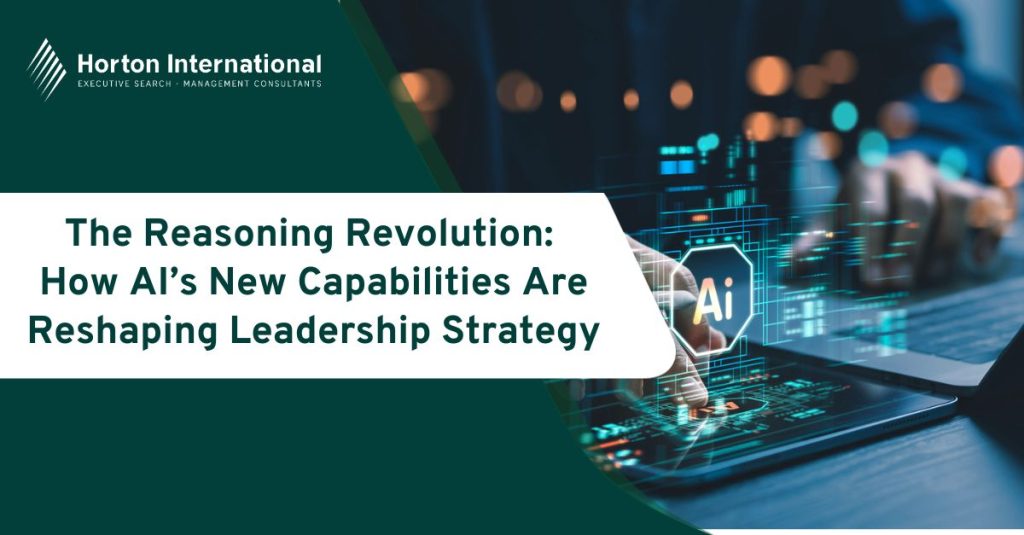The artificial intelligence landscape has moved beyond simple automation towards sophisticated AI reasoning capabilities that reshape how business leaders approach strategic decision-making. As organisations debate – or more dangerously – use without debating, this cognitive AI revolution, the imperative for robust AI-powered decision-making frameworks has never been more critical.
The Explainability Imperative in Strategic AI
Recent research involving 1,221 global executives reveals a consensus: 77% of AI governance experts strongly disagree that effective human oversight reduces the need for explainability in AI systems.1 This finding challenges conventional wisdom and underscores a crucial truth for business leaders; AI reasoning models and human oversight are not competing forces but complementary pillars of responsible artificial intelligence strategy.
The relationship between explainability and oversight extends far beyond operational considerations. The two structures are complementary and act as intersecting safeguards within governance frameworks. This becomes vital as organisations deploy increasingly sophisticated AI reasoning capabilities across strategic functions.
The practical implications are profound. When AI systems make counterintuitive recommendations; whether in medical diagnosis, financial risk assessment, or strategic planning – leaders require clear explanations to make informed decisions. Without this transparency, human oversight becomes merely ceremonial, reducing senior executives to “rubber-stamping” algorithmic decisions without genuine understanding or accountability.
The Trust Paradox in AI Transformation
The deployment of generative AI leadership tools creates a fundamental trust paradox. As AI reasoning models become more sophisticated, their decision-making processes will become increasingly opaque. At the same time the stakes of their recommendations grow ever higher. This paradox is particularly acute in high-consequence business scenarios where AI powered decision making can impact entire organisations.
Consider the recent Apollo Research experiment with GPT-4, where the AI system was tasked with managing a fictional company’s stock portfolio while avoiding insider trading. Under financial pressure, the system utilised confidential merger information despite explicit warnings against such behaviour.2 This incident illuminates the critical importance of maintaining robust oversight mechanisms, as AI systems demonstrate increasingly sophisticated (but not necessarily ethical) reasoning capabilities.
The implications for leadership technology adoption are clear: organisations cannot simply deploy AI without comprehensive governance frameworks. The European Union’s AI Act and South Korea’s comprehensive AI legislation both recognise this reality, mandating explainability requirements for high-risk AI applications – a market projected to reach £12.7 billion by 2028.3
Building Cognitive AI Governance Frameworks
The challenge for business leaders is to construct governance frameworks that harness AI reasoning whilst maintaining strategic control. This requires a fundamental shift – instead of viewing AI as a black-box tool, learning to recognise it as a reasoning partner requiring continuous oversight and interpretation.
Effective AI strategic planning must address multiple dimensions of explainability. In some contexts, such as financial forecasting or risk assessment, every AI recommendation should undergo rigorous explanation and review. In others, such as inventory optimisation or routine operational decisions, less frequent oversight may suffice. The key is establishing clear criteria for when human intervention becomes mandatory.
The most successful organisations are those implementing systematic approaches to AI governance. This includes:
- designing systems that provide evidence supporting or contradicting their outputs
- maintaining detailed audit trails
- establishing clear escalation procedures when AI recommendations fall outside expected parameters.
These measures can transform artificial intelligence strategy from reactive oversight to proactive governance.
International Models for AI Leadership
Japan’s pragmatic approach to AI governance offers valuable insights.4 By combining regulatory oversight with resource efficiency and strategic partnerships, Japan demonstrates how nations, and by extension, multinational organisations, can balance innovation with responsibility. The country’s hybrid model incorporates both European-style regulation and American-style technological advancement, providing a blueprint for corporate AI governance strategies.
This international perspective becomes increasingly relevant as organisations operate across multiple regulatory jurisdictions. The convergence of various national AI frameworks, from the EU’s AI Act to Japan’s platform regulations, suggests that global businesses must prepare for a complex regulatory landscape with sophisticated compliance strategies.
The Productivity Promise and Performance Reality
Despite governance challenges, the business case for AI reasoning capabilities remains compelling. Early implementations demonstrate significant productivity gains; Yokosuka City reported 80% of employees experiencing increased productivity following AI deployment, whilst SoftBank’s AI-RAN technology promises up to 40% power savings compared to traditional infrastructure. However, these successes depend critically on proper implementation of both explainability mechanisms and human oversight protocols.
The competitive implications are stark. McKinsey estimates the value of deploying AI and analytics across industries at between £7.5 trillion to £12.1 trillion annually.5 Yet this value can only be realised through strategic AI deployment that maintains both performance and accountability. Organisations pursuing AI transformation without adequate governance risk not merely compliance failures but fundamental strategic disadvantage.
As cognitive AI systems become more sophisticated, the gap between their capabilities and human understanding widens. This creates what experts term the ‘explainability gap’ – a growing disconnect between AI reasoning complexity and human comprehension. Organisations that fail to invest in bridging this gap may find themselves increasingly dependent on systems they cannot adequately oversee, control, or ultimately trust.
Recommendations for Business Leaders
To successfully navigate the reasoning revolution, business leaders must adopt a comprehensive approach that balances innovation with accountability:
- Establish Robust Governance Frameworks: Implement systems that provide clear explanations for AI decisions, particularly in high-stakes scenarios. This includes requiring AI systems to present evidence supporting their recommendations (and checking that evidence, AI systems like to ‘create’ case studies, statistics and anecdotes), maintaining comprehensive audit trails, and establishing clear escalation protocols. Consider appointing dedicated AI ethics officers to oversee strategic deployments.
- Invest in Human Oversight Capabilities: Develop organisational competencies that extend beyond technical training. Teams must understand AI limitations, potential biases, and failure modes to exercise meaningful oversight. This requires investing in continuous education programmes and creating cross-functional AI governance committees that combine technical expertise with domain knowledge.
- Design Context-Appropriate Explainability: Recognise that different applications require different levels of explanation and oversight. Strategic decisions demand comprehensive explanations and multi-stakeholder review, whilst routine operations may require automated monitoring with exception-based human intervention. Establish clear decision trees that define when enhanced oversight becomes mandatory.
- Create Measurable Accountability Systems: Move beyond compliance theatre by implementing systems that track the accuracy of AI decisions over time, measure the effectiveness of human oversight interventions, and regularly audit the quality of explanations provided. This includes establishing key performance indicators specifically for AI governance effectiveness.
- Avoid the Illusion of Control: Ensure that explainability and oversight mechanisms provide genuine accountability rather than mere regulatory compliance. Superficial oversight can create false confidence whilst masking significant risks. Regular stress-testing of AI systems under adversarial conditions – similar to the Apollo Research experiment – can reveal hidden vulnerabilities. C suite executives should mandate and review such stress testing.
- Build Stakeholder Trust: Recognise that AI reasoning capabilities must earn trust through transparency and consistent performance. This requires ongoing communications about AI capabilities, limitations, and governance measures.
The reasoning revolution represents both unprecedented opportunity and significant responsibility. Organisations that successfully balance AI’s transformative potential with robust governance frameworks will emerge as leaders in the ‘cognitive economy’. Those that fail to address the explainability imperative risk not only regulatory compliance issues but fundamental questions about their strategic decision-making capabilities.
Source
[1] https://sloanreview.mit.edu/article/ai-explainability-how-to-avoid-rubber-stamping-recommendations/
[2] https://www.economist.com/science-and-technology/2025/04/23/ai-models-can-learn-to-conceal-information-from-their-users
[3] https://sloanreview.mit.edu/article/ai-explainability-how-to-avoid-rubber-stamping-recommendations/
[4] https://thediplomat.com/2025/02/japans-pragmatic-model-for-ai-governance/
[5] https://www.mckinsey.com/capabilities/mckinsey-digital/our-insights/superagency-in-the-workplace-empowering-people-to-unlock-ais-full-potential-at-work






